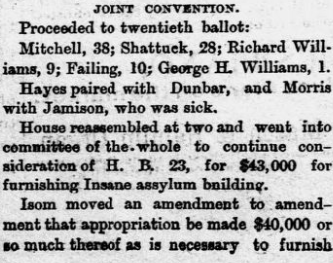image courtesy of USGenWeb Archives Penny
Postcards
Are you missing a burial for family
members who were patients? The Oregon
Health Authority has a listing of
Unclaimed Cremains
KATU2 News article on trying to
locate missing graves at the Oregon State
Hospital
Oregon Blue Book (online version)
Constitution of Oregon: 2015 Version
Section 4. Residence. For the purpose of
voting, no person shall be deemed to have
gained, or lost a residence, by reason of
his presence, or absence while employed
in the service of the United States, or of
this State; nor while engaged in the
navigation of the waters of this State, or
of the United States, or of the high
seas; nor while a student of any Seminary
of Learning; nor while kept at any alms
house, or other assylum [sic], at public
expence [sic]; nor while confined in any
public prison.?
Researching
I recieved the following information
from Pam Roach and Lyn Horine
I asked my Salem friend whom I collaborate
with and that I consider an expert to
comment on the fact that many Oregon death
certificates for Oregon State Hospital
patients were changed to reflect the
county that the patient was committed from
as the county that the patient died in
instead of Marion County for example where
OSH was and is located in and here is her
answer:
Lyn Horine:
"What I remember about this is mostly
anecdotal - and I can't quite recall how
it came about, but probably from looking
at old dcs (death certs) and finding that
Marion County was crossed out by some
subsequent clerk with the county of
residence prior to OSH written in ink by
another subsequent clerk. The real county
of origin can be validated by searching
the "Great Books" ledgers at Archives and
I have also confirmed a number of those
records by looking in the Ledger for the
names (if one knows when they were first
committed or sentenced, and there is
usually a record (in fine penned hand) of
name, date of commitment/sentence, offense
or diagnosis (and the diagnosis is often
couched in old language especially at OSH,
but also other terms for words like
syphillis are often used. There is often a
time of discharge or death, often a column
for readmit (both for OSH and OSP) and
other "odd" items. In some cases, there
are files or "jackets" for those who were
in OSP that contain more details about
charges against them, or clues to old
newspaper files. The OSP files are missing
a "chunk" but I can't remember the era
missing, but I was searching and found
there a couple of boxes brought over from
OSP that are miscellaneous. I also know
that until the second decade of the 1900s,
many counties didn't trust the Legislature
to stay serious about centralized records,
so there were some creative filing
techniques used!"
"This pretty much stopped in the 1920s
(changing the death county)."
I hope this is helpful to other
researchers. It has made me more curious
to look further at the Archives in Salem
as I haven't looked in the "Great Books"
there.

From Oregon Historical
Newspapers: The Corvallis gazette.
(Corvallis, OR.) 1862-1899, October 13,
1882, Image 3 (link no longer good)
To read more interesting articles on
the Oregon State Asylum in Salem,
check out
Historic
Oregon Newspapers
Asylum Section
2